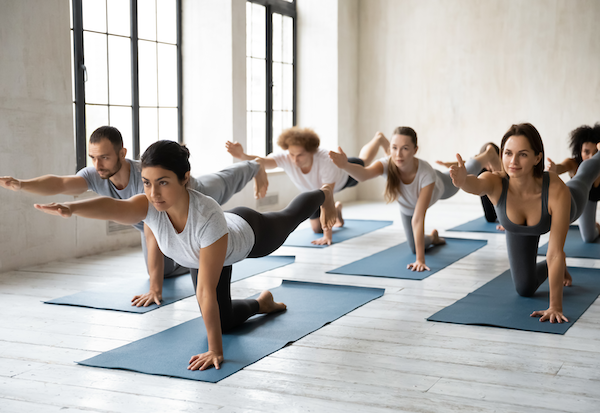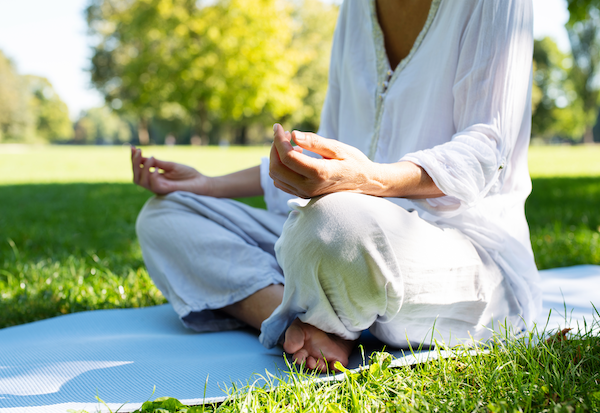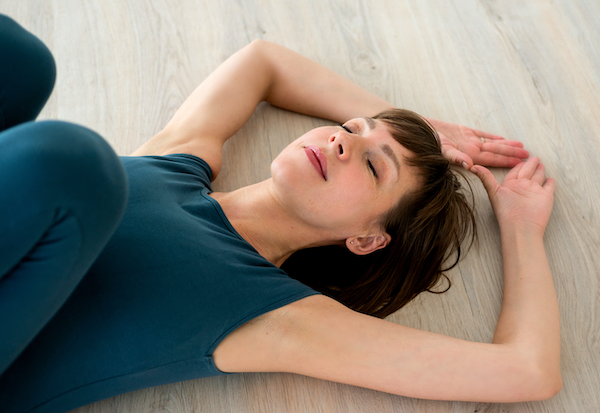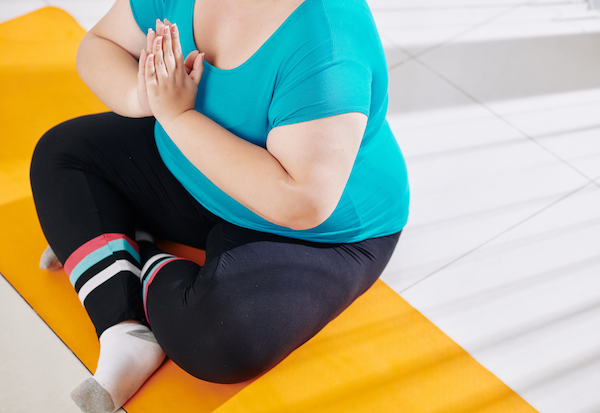
Also known as the Balancing Table Pose, the Sunbird yoga pose is a basic balancing pose that is often practiced in modern yoga classes. It can help you strengthen your core, improve your balance, and increase your focus, so go through this article if you want to learn everything about it.
Table of Contents
Sunbird Yoga Pose Information
- Common name: Sunbird
- English name: Sunbird
- Sanskrit name: Dandayamana Bharmanasana
- Level: Beginner/Intermediate
- Position: On all fours (Tabletop position) with one leg extended back
- Chakras involved: Manipura (Solar Plexus)
- Stretches: Hip flexors, shoulders, chest
- Strengthens: Core muscles, arms, and legs
Anatomy of the Sunbird Yoga Pose
Core Muscles
The Sunbird yoga pose is an excellent posture for strengthening your core muscles. When you’re in the pose, you engage your abdominal muscles, lower back muscles, and glutes to maintain stability and balance. By strengthening these muscles, you can improve your posture, reduce your risk of back pain, and increase your overall strength.
Arms and Shoulders
Your arms and shoulders play a crucial role in the Sunbird yoga pose. As you extend one arm forward, you engage your shoulder muscles, while the other arm provides support. This movement helps to open up your chest and improve your posture.
Legs and Hips
In this pose you extend one leg back, engaging your hip muscles and glutes. This movement helps to strengthen these muscles, improve your balance, and increase your flexibility.
Spine
The Sunbird yoga pose is an excellent posture for lengthening your spine. When you’re in the pose, you stretch your spine, creating space between your vertebrae. This movement can help to reduce back pain, improve your posture, and increase your overall flexibility.
Step-by-Step Instructions
If you’re new to yoga and want to learn how to do the Sunbird pose, this section will guide you through the process step-by-step. Follow these instructions closely to ensure proper alignment, breath, and movement.
Body Alignment
Start on all fours with your hands and knees shoulder-width apart. Your wrists should be directly under your shoulders, and your knees should be directly under your hips. Make sure your fingers are spread wide and pressing firmly into the mat. Your spine should be in a neutral position, with your head in line with your spine and your gaze down at the mat.
Breath and Focus
Take a few deep breaths, inhaling and exhaling through your nose. As you inhale, expand your belly and chest. As you exhale, draw your navel toward your spine to engage your core muscles. Focus on your breath and your body, and let go of any distractions or thoughts.
Movement and Sequence
From your all-fours position, extend your right leg back behind you at hip level, flexing your foot and engaging your glutes. At the same time, extend your left arm forward at shoulder level, reaching through your fingertips and engaging your shoulder blades. Keep your gaze down on the mat to maintain balance.
Stabilize your core and hold the pose for a few breaths, then release and return to all fours. Repeat the pose on the other side, extending your left leg back and your right arm forward.
Repeat this sequence several times, flowing smoothly from one side to the other. As you become more comfortable with the pose, you can hold it for longer periods and incorporate it into your yoga practice.
Remember to focus on good posture and alignment, engaging your core and stabilizing your foundation. With practice, the Sunbird pose can help you strengthen your core muscles, stretch your spine, and improve your balance and flexibility.
That’s it! With these simple instructions, you can learn how to do the Sunbird pose and make it a regular part of your yoga practice.
Beginner’s Tips
If you’re starting with yoga, the Sunbird yoga pose is great. Here are some beginner’s tips to help you get started:
- Start on all fours with your hips directly above your knees. Your thighs, knees, calves, ankles, and feet should be hip distance apart from one another.
- Your hands and arms should be shoulder distance apart. Stack your shoulders over the elbows and wrists. Spread your fingers wide and root down through the index, thumb, and pinky fingers.
- Lengthen your whole spine. Reach the crown of your head toward the top of your mat and stretch your sit bones in the opposite direction.
- On an exhalation, activate your core by drawing the muscles around your whole lower abdomen toward your spine.
- On an inhalation, reach your right leg straight back behind you to roughly the height of your hip. Keep your toes pointed and your foot flexed.
- Keep your gaze down toward the floor to maintain a neutral neck and spine. Hold the pose for a few breaths, then release and repeat on the other side.
Remember to take it slow and listen to your body. If you feel any pain or discomfort, come out of the pose and take a break. As you continue to practice, you’ll build strength and flexibility, and the Sunbird Pose will become easier.
Sunbird Yoga Sequences Contraindications
While Sunbird Pose is generally considered a safe and beneficial yoga posture, there are some contraindications to keep in mind before practicing it. Here are some of the most important things to consider:
Injury and Surgery
If you have any knee, ankle, or wrist injuries, it’s best to avoid practicing Sunbird Pose. This is because the pose requires balancing on one hand and one knee, which can put pressure on these joints and exacerbate any existing injuries.
Pregnancy
If you’re pregnant, it’s important to be cautious when practicing Sunbird Pose. While the pose can help strengthen the core muscles and improve balance, it also involves balancing on one hand and one knee, which can be challenging and potentially risky for pregnant women.
High Blood Pressure
If you have high blood pressure, it’s important to be careful when practicing the Sunbird yoga pose. The pose can be physically demanding and may cause your blood pressure to rise, which can be dangerous if you already have hypertension.
Dizziness or Vertigo
If you experience dizziness or vertigo, it’s best to avoid practicing the Sunbird yoga pose. The pose involves balancing on one hand and one knee, which can be disorienting and potentially exacerbate these symptoms.
Modifications and Alternatives
If you have any of these contraindications, don’t worry – there are still plenty of ways to reap the benefits of this pose. You can modify the pose by using a block or bolster for support, or you can try alternative postures that provide similar benefits, such as Cat-Cow or Downward Facing Dog. As always, it’s important to listen to your body and practice yoga in a way that feels safe and comfortable for you.
Sunbird Yoga Sequences
Sunbird Pose is a great way to strengthen your core and improve your balance. Here are some sequences that you can try out:
Sequence 1
- Begin in a tabletop position, with your hands and knees on the ground.
- Extend your right arm forward and your left leg back, keeping them parallel to the ground.
- Hold for a few breaths, then return to the tabletop position.
- Repeat on the other side, extending your left arm forward and your right leg back.
Sequence 2
- Start in a tabletop position.
- Extend your right arm forward and your left leg back, as in Sequence 1.
- Slowly bend your left knee and reach your right hand back to grab your left foot.
- Hold for a few breaths, then release and return to the tabletop position.
- Repeat on the other side, extending your left arm forward and your right leg back, then grabbing your right foot with your left hand.
Sequence 3
- Begin in a downward-facing dog position.
- Inhale and lift your right leg behind you.
- Exhale and bring your right knee to your right elbow.
- Inhale and extend your right leg back, then exhale and bring it to your left elbow.
- Inhale and extend your right leg back again, then exhale and bring it to your nose.
- Step your right foot forward between your hands and come into a low lunge.
- Lift your torso up and raise your arms overhead, coming into a high lunge.
- Bring your hands to your heart center and twist to the right, hooking your left elbow outside your right knee.
- Hold for a few breaths, then release and step back into the downward-facing dog.
- Repeat on the other side, lifting your left leg up and following the same sequence.
These Sunbird yoga pose sequences are a great way to challenge your balance and build strength in your core and legs. Remember to breathe deeply and move slowly, focusing on your alignment and form.
Common Variations of Sunbird Yoga Pose
If you’ve been practicing Sunbird Pose for a while and are looking for ways to spice things up, there are several variations you can try. Here are a few common ones:
- Extended Leg Variation: Instead of extending your opposite arm and leg, try extending both legs behind you, keeping them hip distance apart. This variation will challenge your balance and core strength even more.
- Twisted Variation: Inhale as you extend your arm and leg, then exhale as you bring your elbow and knee to touch underneath your body. This twisted variation will help improve spinal mobility and digestion.
- Breath-Synchronized Variation: As you inhale, extend your arm and leg, and as you exhale, bring them back in. Syncing your breath with your movement can help calm your mind and improve focus.
- Jumping Variation: If you’re feeling adventurous, try jumping into Sunbird Pose from Downward-Facing Dog. From there, jump back into Downward-Facing Dog and repeat. This variation will get your heart rate up and challenge your coordination.
Remember to listen to your body and only try variations that feel safe and comfortable for you. As always, consult with your healthcare provider before starting any new exercise routine.
Sunbird Yoga Pose Benefits
Sunbird Pose is an outstanding yoga posture that offers numerous physical and mental benefits. This pose is also known as the Balancing Table Pose. Let’s take a closer look at some of the benefits of this pose.
Physical Benefits
Sunbird Pose is a great way to strengthen your core muscles. This pose requires you to engage your abdominal muscles, which can help improve your core strength. Additionally, Sunbird Pose can help improve your posture by strengthening the muscles in your back. This can help you stand up straighter and improve your overall posture.
Sunbird Pose also helps to improve your flexibility. This pose requires you to stretch your arms and legs, which can help improve your overall flexibility. Additionally, Sunbird Pose can help to strengthen your arms, shoulders, and wrists.
Mental Benefits
Sunbird Pose can also help to reduce stress and anxiety. This pose requires you to focus on your breath and your body, which can help to calm your mind. Additionally, Sunbird Pose can help to improve your balance and coordination, which can help to improve your overall sense of well-being.
Sunbird Pose can also help to improve your intuition. This pose requires you to focus on your body and your breath, which can help to improve your overall awareness. Additionally, Sunbird Pose can help to improve your overall sense of lightness and warmth.
Overall, Sunbird Pose is a great yoga posture that offers numerous physical and mental benefits. Whether you are a beginner or an experienced yogi, Sunbird Pose is a great way to improve your core strength, flexibility, and overall sense of well-being.
Before You Go…
If you’re looking for a yoga pose that can help you strengthen your core, improve your balance, and increase your focus, then Sunbird Pose might be just what you need.
If you are interested in learning particular yoga poses, you should take a look at the articles we have published covering some of them:
- Airplane Yoga Pose – Everything You Need to Know
- Square Yoga Pose – Everything You Need to Know
- The Best 3 Person Yoga Poses
- The Best 4 Person Yoga Poses



